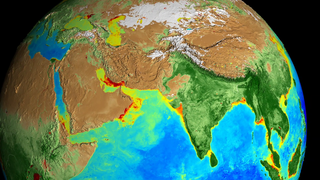Stunning New Global Portrait Celebrates 20 Years of Studying Life on Earth from Space Live Shots
Show Your Viewers How the Ecosystems in Your Region Are Changing
NASA Creates the Ultimate Timelapse of Life on Earth
NASA scientists now have the most complete global picture of life on Earth to date. From the unique vantage point of space, NASA observes not only Earth’s landmasses and oceans but also the organisms that live among them. We see the entire Earth breathing, growing and changing.
Join NASA scientists from 6:00-11:30 a.m. ET on Friday, Nov. 17, to see a new timelapse of life on our entire planet over the last two decades, in addition to a close-up view of your region. We’ll show your viewers how NASA data is being used to study the health of ecosystems close to home.
A true understanding of our planet requires us to keep a keen eye on its living inhabitants. With NASA's fleet of Earth-observing satellites, scientists can track worldwide changes in vegetation, marine life, human development and more. We’ve seen fisheries evolving, deserts expanding, spring coming earlier and fall coming later. Seeing these kinds of changes occur all over the world has taught us a lot about the ingredients for life and the environmental conditions that can sustain it.
We only know of one planet that pulses with life. NASA's outlook from space shows us what makes Earth different from the thousands of other planets we’ve discovered so far. And when considering the vastness of unlivable space, Earth seems evermore fragile and beautiful.
*****To book a window contact*****
Micheala Sosby / micheala.m.sosby@nasa.gov / 219-331-5864
HD Satellite Coordinates for G17-K17 Lower: Galaxy 17 Ku-band Xp 17 Slot Lower| 91.0 ° W Longitude | DL 12031.0 MHz | Horizontal Polarity | QPSK/DVB-S | FEC 3/4 | SR 13.235 Mbps | DR 18.2954 MHz | HD 720p | Format MPEG2 | Chroma Level 4:2:0 | Audio Embedded
Suggested Questions:
1. This new timelapse shows 20 years of life on Earth. Show us what’s happening here.
2. What trends has NASA observed over the last two decades of studying life on Earth?
3. How are the ecosystems in our region changing?
4. How is Earth helping us search for life on other worlds?
5. Where can we learn more?
Extra Questions for Longer Interviews:
1. What makes this data set of life on Earth so special?
2. What tools is NASA using to study Earth’s ecosystems from space?
3. What are some of the surprising uses of this data set?
4. What do plants tell us about the health of life on Earth?
5. With this view from space, what have scientists learned about Earth’s carbon cycle?
6. Why is NASA’s view from space so important for understanding Earth’s oceans?
Location: NASA's Goddard Space Flight Center/Greenbelt, Maryland
Scientists:
Dr. Ivona Cetinic/NASA Oceanographer
Dr. Compton Tucker/NASA Earth Scientist
Dr. Jeremy Werdell/NASA Oceanographer
Dr. Carlos del Castillo/NASA Oceanographer
Related
Credits
Micheala Sosby (NASA/GSFC): Lead Producer
Clare Skelly (NASA/GSFC): Producer
Michael Randazzo (Advocates in Manpower Management, Inc.): Lead Editor
NASA's Goddard Space Flight Center
https://svs.gsfc.nasa.gov/12774
Keywords:
SVS >> HDTV
SVS >> Hyperwall
NASA Science >> Earth












